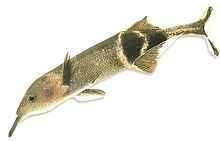 Global Information
Global InformationMormyroidea information
| Mormyroidea | |
|---|---|

| |
| Elephantnose fish | |
| Scientific classification | |
| Domain: | Eukaryota |
| Kingdom: | Animalia |
| Phylum: | Chordata |
| Class: | Actinopterygii |
| Order: | Osteoglossiformes |
| Superfamily: | Mormyroidea |
The Mormyroidea (synonymy: Mormyriformes) are a superfamily (formerly an order) of fresh water fishes endemic to Africa that, together with the families Hiodontidae, Osteoglossidae, Pantodontidae and Notopteridae, represents one of the main groups of living Osteoglossiformes.[1] They stand out for their use of weak electric fields, which they use to orient themselves, reproduce, feed, and communicate.[2][3]
There is no consensus regarding its superior biological classification as some experts point out that it belongs to the suborder Osteoglossoidei, while others to the Notopteroidei. In either case, the mormyriformes include the gymnarchids and mormyrids[4] and represent the largest superfamily within the order Osteoglossiformes with about two hundred and thirty-three subordinate taxa[5] that are distributed across various watersheds existing throughout tropical Africa south of the Sahara, including the Nile,[6] Turkana, Gambia, and northern South Africa.[7][8][9]
These fish have a large brain and an unusual intelligence,[10] they feed on benthic and allochthonous invertebrates, as well as some crustaceans found in marshy and sandy areas of rivers and lakes.[11] Most of its species are sociable, and although their reproductive form is little known, they generally reproduce during the rainy season and their electrical organs transmit signals with the capacity to influence their reproductive and hormonal behavior.[12][13]
According to the International Union for Conservation of Nature (IUCN), the conservation status of 66.7% of the species is Least Concern and 10.8% is Threatened species.[14] Furthermore, according to the same institution, the extinction rate of the taxon – at least in the northern region of the African continent – reaches 44.4%, while 55.6% of the individuals are threatened.[15]
- ^ Wilson, M. V. H.; Murray, A. M. (2008). "Osteoglossomorpha: phylogeny, biogeography, and fossil record and the significance of key African and Chinese fossil taxa". Geological Society, London, Special Publications. 295: 185–219. doi:10.1144/SP295.12. S2CID 84322935.
- ^ Hollmann, Michael; Engelmann, Jacob; von der Emde, G. (2008). "Distribution, density and morphology of electroreceptor organs in mormyrid weakly electric fish: anatomical investigations of a receptor mosaic". Journal of Zoology. 276 (2): 149–158. doi:10.1111/j.1469-7998.2008.00465.x. ISSN 1469-7998.
- ^ Pusch, R.; von der Emde, G.; Hollmann, M.; Bacelo, J.; Nöbel, S.; Grant, K.; Engelmann, J. (2008). "Active sensing in a mormyrid fish – Electric images and peripheral modifications of the signal carrier give evidence of dual foveation". Journal of Experimental Biology. 211 (Pt 6): 921–934. doi:10.1242/jeb.014175. PMID 18310118. S2CID 1148095.
- ^ Hopkins, Carl D. (1999). "Signal Evolution in Electric Communication". The Design of Animal Communication. MIT Press. ISBN 978-02-6258-223-0.
- ^ "Mormyroidea: taxa subordinado". Canadian Biodiversity Information Facility (CBIF). 14 December 2021.
- ^ Skelton, Paul Harvey (2001). A complete guide to the freshwater fishes of Southern Africa. South Africa: Struik Publishers. pp. 395. ISBN 978-18-6872-643-1.
- ^ Witte, Frans; van Oijen, Martien J.P.; Sibbing, Ferdinand A. (2009). "Fish Fauna of the Nile". The Nile: Origin, Environments, Limnology and Human Use. Belgium: Springer. pp. 818. ISBN 978-14-0209-725-6.
- ^ Seegers, Lothar (1996). The fishes of the Lake Rukwa drainage. Belgium: Koninklijk Museum voor Midden-Afrika. p. 407. ISBN 978-90-7589-403-5.
- ^ Berra, Tim M. (2007). Freshwater Fish Distribution. Chicago: University of Chicago Press. pp. 615. ISBN 978-02-2604-442-2.
- ^ Tiwari, S. K. (1999). Animal Kingdom of the World, Volume 2: Faunal Regions of the world. New Delhi: Sarup & Sons. p. 670. ISBN 978-81-7625-071-9.
- ^ Mikuriya, Beverly A. (1972). "The gross anatomy and microscopic anatomy of the tongue and lower jaw of Gnathonemus petersii (Gthr. 1862) (Mormyridae, Teleostei)". Zoomorphology. 73 (3): 195–208. doi:10.1007/BF00297205. ISSN 0720-213X. S2CID 12988848.
- ^ Sterba, Günther (1999). Süsswasserfische der Welt (in German). Augsburg: Weltbild. p. 914. ISBN 978-38-9350-991-1.
- ^ Simon, Neal (2002). "Hormonal Processes in the Development and Expression of Aggressive Behavior". Hormones, Brain and Behavior. Vol. 1. Academic Press. ISBN 978-00-8053-415-2.
- ^ IUCN (2011). "IUCN Red List of Threatened Species. Version 2011.2". IUCN Red List.
- ^ García, N.; Cuttelod, A.; Abdul Malak, D. (2011). The status and distribution of freshwater biodiversity in northern Africa. Switzerland: IUCN. p. 141. ISBN 978-28-3171-271-0.